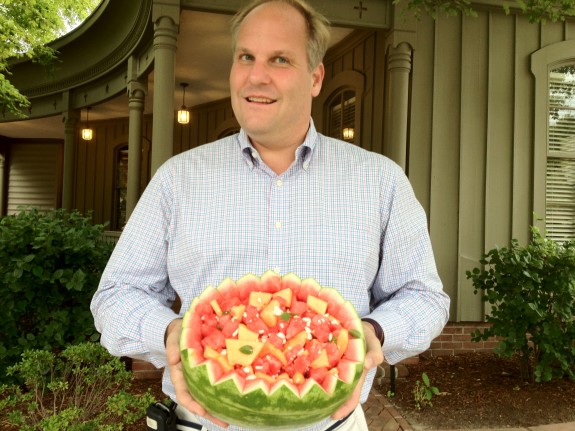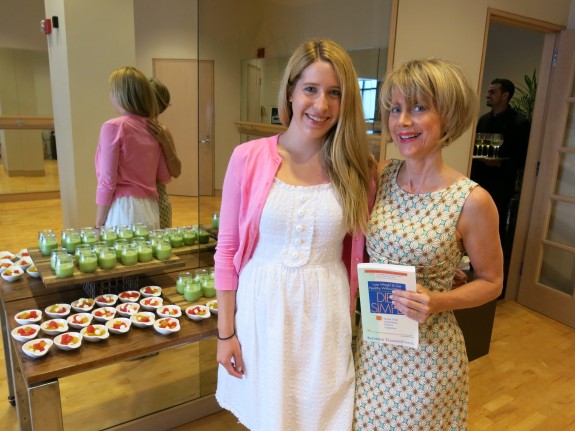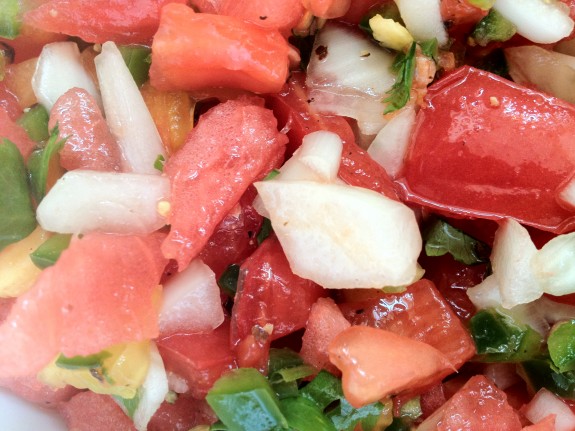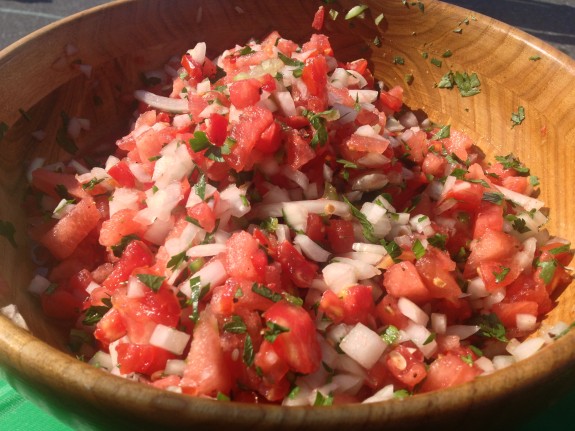The Perfect Labor Day Recipe: Katherine’s Salsa Fresca with Watermelon
- At September 01, 2017
- By Katherine
- In News, Recipes
 0
0
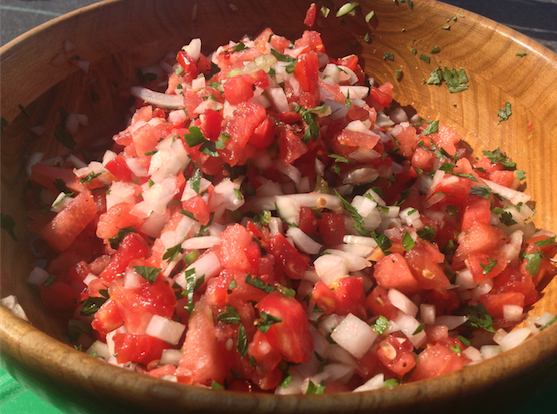
Katherine’s Spicy Salsa Fresca with Watermelon from “Diet Simple Farm to Table Recipes: 50 New Reasons to Cook in Seasons!”
Katherine’s Spicy Fresh Salsa with Watermelon
www.KatherineTallmadge.com
excerpted from “Diet Simple Farm to Table Recipes: 50 New Reasons to Cook in Season!” ($4.95)
Nothing could be a more perfect Labor Day recipe. Featuring the best fruit of the season! It contains all the flavors: sweet, savory, spicy, and salty. I usually use vine-ripe tomatoes for my fresh salsa, excerpted from my book, Diet Simple. But watermelon is a surprising and exotically delicious substitute for all the tomatoes, or just half of them – as in this version. Serve this salsa with grilled salmon, chicken or beef… even tortilla chips… whatever you may traditionally use salsa with.
22 servings
Ingredients:
1 lb vine-ripe, fresh tomatoes, coarsely chopped (start with about 1-1/2 lbs)
1 lb chopped watermelon, seeds removed
1 large candy onion, peeled and chopped (about ½ pound)
3 – 4 jalapeno peppers (1 – 2 ounces), to taste
¼ cup chopped fresh cilantro
½ tsp salt, or to taste
freshly ground pepper, to taste
3 – 4 Tbsp fresh lime juice (1 – 2 limes), optional, or vinegar if you wish for the salsa to last longer in your refrigerator
Add the onion to the tomatoes and watermelon. Finely chop 2 of the jalapeno peppers to start with. Taste. If you desire more heat, add 1 – 2 more jalapenos. Mix in the cilantro. Add the salt and pepper, depending on your taste. Mix in the lime juice, if you wish.
Sweet Summertime Melon Chunks with Crumbled Feta and Fresh Mint
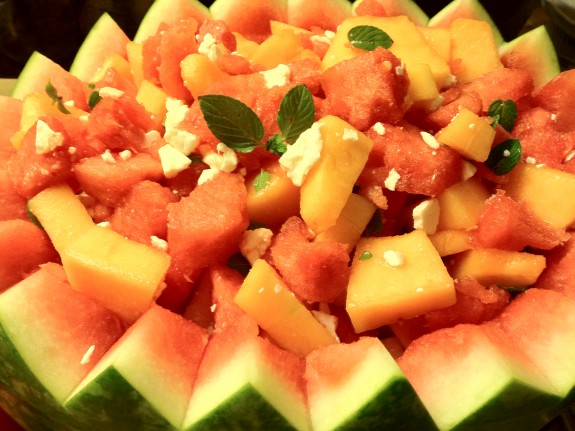
Sweet Summertime Melon Chunks with Crumbled Feta and Fresh Mint (from “Diet Simple Farm to Table Recipes”)
Excerpted from “Diet Simple Farm to Table Recipes: 50 New Reasons to Cook in Season!“
It’s melon season and a vast number of varieties are now available, and will be for quite a while. These days melons come in an amazing array of colors, shapes, textures, and flavors. Use a combination of any melons for this very simple, yet elegant recipe. This is an unusual combination of flavors and textures, and a delight on the palate. Use any kind of melon that happens to be in season.
Serves 8
2 pounds melon chunks (about 1 small cantaloupe or seedless watermelon)
½ pound Feta Cheese or other similar cheese
8 small mint leaves, Chiffonade (Basil will also work)
Combine ingredients in a large bowl and serve!
Preventing Prostate Cancer Through Diet and Lifestyle
- At October 03, 2013
- By Katherine
- In Articles, News
 1
1
Nutrition makes a difference!
by Viggy Parr with contributions by Katherine Tallmadge
When men move to the United States or adopt a more westernized diet, their prostate cancer rates increase dramatically.
Based on international comparisons of prostate cancer rates in different countries and over time, studies where researchers examine the lifestyle and health of a group in one location and compare that to the lifestyle and health of a group in a different location—have shown that Asian men, who have some of the lowest worldwide rates of prostate cancer, increase their risk of that cancer when they adopt a Western (American) diet with more animal foods. A recent study (Ahmedin et al, 2010) found that rates of prostate cancer are rising in countries with formerly low rates, such as Japan and Singapore because of westernization, including a sedentary lifestyle, diets filled with animal fats, and rising rates of obesity. These results prove that there is not necessarily a genetic protection against prostate cancer in Asian men, but rather a strong environmental factor.
I hope that the following lifestyle advice can benefit all men and help them to significantly reduce their risk of prostate cancer and help them to live a long and healthy life! (1) Learn more about PSA testing controversies..
1. Body fat: The American Institute for Cancer Research recommends at least 30 minutes of physical activity each day to reduce body fat and help prevent cancer in general. This recommendation is particularly important for prostate cancer.
“Although most men will develop prostate cancer if they live long enough, the cancer often remains dormant and never impacts their health. Only a small minority of men will develop the aggressive form of prostate cancer that can be fatal,” ccording to Karen Collins, MS, RDN, a registered dietitian and nutrition advisor for the American Institute for Cancer Research (AICR).
Overweight men are more at risk for aggressive prostate cancer than men of normal weight. The reasons behind this are not entirely clear; Collins suggests that the hormone changes involved in weight gain or even obesity-caused chronic low-grade inflammation could be the culprit. Inflammation is associated with many cancers for reasons that are not fully understood. Collins explains that inflammation could set off changes in cell signaling pathways that could lead to changes in cell growth and reproduction and the cell’s ability to self-destruct, ultimately leading to cancer.
- Bottom line: You don’t have to spend hours at the gym to get the cancer-preventing health benefits of exercise—a simple walk through the neighborhood can do wonders for your health. Exercise can be fun, too—try an active game of golf or badminton with friends, yoga, kayaking, paddle boarding, volleyball, swimming—any activity that gets your heart pumping is perfect!
- Body fat: 8 Steps to Determine – Are YOU dangerously overweight? Learn more about PSA testing controversies!
2. Lycopene (Red fruits such as tomatoes, watermelon, guava): Many studies have shown that lycopene-rich foods reduce the risk of prostate cancer, but the mechanism behind that reduction was not well understood until now. A recent study found that lycopene has a substantial protective effect against prostate cancer by interfering with the genes that would allow the prostate cancer cells to grow and survive. The American Institute for Cancer Research recommends that men take advantage of lycopene’s cancer-preventing effects and fill their diets with foods such as tomatoes, watermelon and guava.
- Bottom line: Fill your diet with lycopene-rich foods such as tomatoes, watermelon, and red grapefruit. Remember—the cancer-fighting properties of lycopene in tomatoes are much stronger when the tomatoes are cooked, such as in marinara sauce or tomato soup.
- Source: Rafi, MM, S Kanakasabai, MD Reyes, and JJ Bright. “Lycopene modulates growth and survival associated genes in prostate cancer.” Journal of Nutritional Biochemistry 2013.
3. Selenium: The AICR recommends incorporating selenium-rich foods into your diet to help decrease your prostate cancer risk. Selenium is essential to proper immune system and thyroid functioning, and it has been shown to be anti-carcinogenic. In addition to its powerful preventive effects, selenium may also slow prostate tumor growth. One of the best sources of selenium is the Brazil nut. Besides being a great selenium reservoir, Brazil nuts are high in protein, fiber, magnesium, and phosphorus, along with vitamin E, vitamin B6, calcium, and iron, just to name a few. These nutrient powerhouses can also help lower cholesterol.
- When paired with vitamin E, selenium packs an extra punch in preventing prostate cancer. Almonds are a great source of vitamin E and have a host of other health benefits, as well.
- Bottom line: Enjoy selenium-rich foods such as brazil nuts, sunflower seeds, eggs, mushrooms, grains, and onions to help lower your risk of prostate cancer.
- Source: Yang, Jun. “Brazil nuts and associated health benefits: A review.” LWT-Food Science and Technology 42(10): 2009.
4. Cruciferous vegetables: Consumption of vegetables in the crucifer family, including broccoli, cauliflower, and cabbage has recently been linked to a decrease in prostate cancer risk. Chemicals in vegetables like broccoli can suppress the growth of prostate cancer cells and therefore prevent development of the disease.
- Source: Watson, GW, LM Beaver, DE Williams, RH Dashwood, and E Ho. “Phytochemicals from Cruciferous Vegetables, Epigenetics, and Prostate Cancer Prevention.” The American Association of Pharmaceutical Scientists Journal: 2013. http://www.ncbi.nlm.nih.gov/pubmed/23800833
- Bottom line: Even if delicious, nutritious foods like broccoli and cauliflower don’t definitively reduce your risk of prostate cancer, they are still incredibly healthful foods with a huge variety of proven benefits. Toss some broccoli into your salad or replace the mashed potatoes with some smashed cauliflower!
5. Vegetable fats: A long-term study of men with prostate cancer found that men who ate more vegetable fats (think nuts, avocados, and nut oils) had a significantly reduced risk of dying from any cause. Simply swapping ten percent of daily carbohydrates for vegetable fats lowered the men’s risk of death by 26 percent, and swapping vegetable fats for ten percent of daily animal fat reduced the men’s risk of death by a whopping 34 percent.
- Bottom line: Instead of cooking foods in trans-fatty oils or bacon fat, use olive or peanut oil. Foods such as nuts, avocados, peanut butter, and olives are good sources of vegetable fats, as well.
- Source: Richman, Erin L., Stacey A. Kenfield, Jorge E. Chavarro, Meir J. Stampfer, Edward L. Giovannucci, Walter C. Willett, and June M. Chan. “Fat Intake After Diagnosis and Risk of Lethal Prostate Cancer and All-Cause Mortality.” JAMA Internal Medicine 2013. http://www.ncbi.nlm.nih.gov/pubmed/23752662
6. Animal fats: Frequent meat-eaters beware: studies have shown that diets high in animal fats can increase your risk for prostate cancer. Studies of the often vegetarian Seventh-Day Adventists show decreased rates of prostate cancer in that population compared to the national average.
- Source: Le Marchand, Loic, Laurence N. Kolonel, Lynne R. Wilkens, Beth C. Myers, and Tomio Hirohata. “Animal Fat Consumption and Prostate Cancer: A Prospective Study in Hawaii.” Epidemiology 5(3): 1994. http://www.ncbi.nlm.nih.gov/pubmed/8038241
- Milk: A recent studyfound that whole milk, which is high in animal fat, is associated with more aggressive, fatal prostate cancer. Skim/low-fat milk was associated with less aggressive prostate cancers. Some researchers believe that the calcium in milk may be behind milk’s association with prostate cancer, while others believe that natural growth factors in milk are the true cause. Men are urged to be careful about calcium supplements—as with many types of foods, it’s necessary to find the middle ground between too much and too little calcium. Whereas excessive calcium (1200-1500+ mg/day) is associated with increased prostate cancer risk, adequate calcium consumption in general is pretty clearly associated with lower risk of colon cancer. According to Collins, “You’d hate for men to get the idea that they should totally minimize their calcium intake, since some calcium in moderate amounts doesn’t seem to increase prostate cancer risk.”
- Source: Song, Y, JE Chavarro, Y Cao, W Qiu, L Mucci, HD Sesso, MJ Stampfer, E Giovannucci, M Pollak, S Liu, and J Ma. “Whole milk intake is associated with prostate cancer-specific mortality among U.S. male physicians.” Journal of Nutrition 143(2): 2013. http://www.ncbi.nlm.nih.gov/pubmed/23256145
- Bottom line: It’s not a bad idea to reduce your meat intake. If you do eat meat, opt for leaner meats such as chicken and fish instead of fatty beef. It also wouldn’t hurt to cut back on milk or switch to skim milk.
7. Soy: Stanford researcher Dr. David Feldman has found that soy can have protective effects against prostate cancer. Genistein, a soy phytochemical, can boost calcium absorption by protecting a vitamin D-derived chemical, calcitriol, against breakdown. A study involving rats found that when placed on a high-soy diet and given supplements of calcitriol, the rats were much less likely to grow prostate tumors.
- Bottom line: This doesn’t mean that you should load up on soy and vitamin D—some of the mice in the soy-vitamin D study developed hypercalcemia, a condition that occurs when there is too much calcium in the blood. Enjoy minimally processed, nonfermented forms of soy every now and then, such as tofu and soy milk.
- Source: Studying D, Soy and Prostate Cancer. AICR Newsletter. http://www.aicr.org/publications/newsletter/2013-winter-120/studying-d-soy-and-prostate.html
- Source: http://www.huffingtonpost.com/craig-cooper/soy-and-chocolate-too-muc_b_756604.html
8. Fried foods: A new study from the University of Washington has found that regularly eating fried foods such as French fries and fried chicken could increase your prostate cancer risk. The high heats involved in deep-frying create new molecular compounds that may be carcinogenic. You don’t necessarily need to swear off doughnuts and fries forever—the study also found that men who ate fried foods one to three times a month did not have an increased risk for prostate cancer.
- Bottom line: Try to replace fried foods with fresh foods whenever possible, but if you simply have to have a doughnut or fries, limit yourself to one or two indulgences per month.
- Source: Stott-Miller, Marni, Marian L. Neuhouser, and Janet L. Stanford. “Consumption of deep-fried foods and risk of prostate cancer.” The Prostate 73(9): 2013. http://www.ncbi.nlm.nih.gov/pubmed/23335051
9. Omega–3 fatty acids: A recent study by Dr. Theodore Brasky and colleagues found that high blood levels of omega-3 fatty acids is associated with an increased risk of prostate cancer. However, the study suffers from several serious methodological flaws. The study did not examine any aspects of diet in the volunteers, nor did they ask if the men were taking fish oil supplements. All assessments of omega-3’s were performed by measuring omega-3 blood levels. Karen Collins of AICR cautions that the real issue is all about balance; the balance of omega-3’s and omega-6’s (another type of essential dietary fat) seems to be very important for inflammation. People who eat little to no fish and fill their diets with processed foods may have inadequate consumption of omega-3’s, whereas someone else could go too far in the other direction and throw off that delicate balance by eating a low fat diet with omega-3 supplements. There is likely a tipping point at which omega-3’s cease being helpful and start to be harmful due to the imbalance that too many omega-3’s can cause, much like calcium and milk. It’s important to recognize that although omega-3’s are important, the rest of the diet and lifestyle must also be taken into account. For example, the Inuits, the native people of Greenland, have a diet rich in fish, giving them plenty of omega-3’s. The Inuits also have incredibly low rates of prostate cancer.
- http://www.cnn.com/2013/07/12/health/salmon-cancer-time/index.html (Brasky research)
- Brasky, TM, AK Darke, X Song, CM Tangen, PJ Goodman, IM Thompson, FL Meyskens, Jr., GE Goodman, LM Minasian, HL Parnes, EA Klein, and AR Kristal. “Plasma Phospholipid Fatty Acids and Prostate Cancer Risk in the SELECT Trial.” Journal of the National Cancer Institute: 2013. http://jnci.oxfordjournals.org/content/early/2013/07/09/jnci.djt174.abstract
- Dewailly, E, G Mulvad, H Sloth Pedersen, JC Hansen, N Behrendt, and JP Hart Hansen. “Inuit are protected against prostate cancer.” Cancer Epidemiology, Biomarkers & Prevention: 12(9): 2003. http://www.ncbi.nlm.nih.gov/pubmed/14504206
Conclusion
By eating in accordance with the most up-to-date scientific evidence, you could help reduce your risk for prostate cancer. Start by filling your diet with lycopene-containing foods like tomatoes, watermelon, and grapefruit, selenium-rich foods like brazil nuts, eggs, and mushrooms, vegetable fats like nuts and avocados, and cruciferous vegetables like broccoli and cauliflower. What you add in is just as important as what you leave out—try to cut back on red meat, whole milk, and fried foods. Top everything off with at least 30 minutes of exercise each day and you’ll be doing both yourself and your family a whole lot of good. Collins points out that “for cancer overall, we are discovering so many protective compounds in food that we should focus on variety rather than a few superstars to eat over and over again.” Take her advice and mix it up once in a while. If you follow all of the tips in this article, you’ll be taking full advantage of the most up-to-date prostate cancer prevention science and improving your overall health along the way!
Sources:
Jemal, Ahmedin, Melissa M. Center, Carol DeSantis, and Elizabeth M. Ward. “Global Patterns of Cancer Incidence and Mortality Rates and Trends.” Cancer Epidemiology, Biomarkers & Prevention 2010. http://cebp.aacrjournals.org/content/19/8/1893.long
Learn more about PSA testing controversies!
Summer’s Last Sigh… Market Recipe: Greek Salad with Heirloom Tomatoes
- At September 27, 2013
- By Katherine
- In News, Recipes
 0
0

Four Seasons Displaying Greek Salad with Heirloom Tomatoes, Tabouleh with Chick Peas, Seasonal Vegetables and a Lemon, Basil Vinaigrette, and Fruit Smoothies, all from "Diet Simple Farm to Table Recipes" and prepared by Four Seasons Hotel Executive Chef Douglas Anderson for my Presentation: 4 Steps to Building Muscular Strength
Don’t say good-by to summer yet. There is still plenty of summer’s most lovely seasonal produce, particulary heirloom tomatoes – my favorite – to entertain with, as evidenced by Four Seasons’ beautifully prepared Greek Salad with Heirloom Tomatoes, and other recipes from Diet Simple Farm to Table Recipes. They were uniquely and beautifully interpreted by the Four Seasons Hotel Executive Chef Douglas Anderson for my presentation, “Four Steps For Strengthening Muscles – Some Surprising News” exclusively for Four Seasons Health Club members.
Every vegetable in the recipe – the tomatoes, cucumbers, peppers, sweet onions, and garlic – can be found at the local Farmers Markets at Rose Park on Wednesday or Dupont Circle on Sunday or any other Fresh Farm Market locations. The possibilities are endless! This is a naturally vegetarian recipe. But for the meat lovers, it’s great with grilled chicken or seafood on the side.
“Katherine’s Market Recipes,” are designed to be delicious, easy, quick, family-friendly, nutritious (heart-healthy & diabetes-friendly), and to highlight produce found at our local Farmers Markets this week. At your Farmers Market, you’ll find produce picked at peak ripeness, which means maximum flavor, texture and nutrition. You’re also helping save the environment when you buy at your Farmers Market. Here’s how…
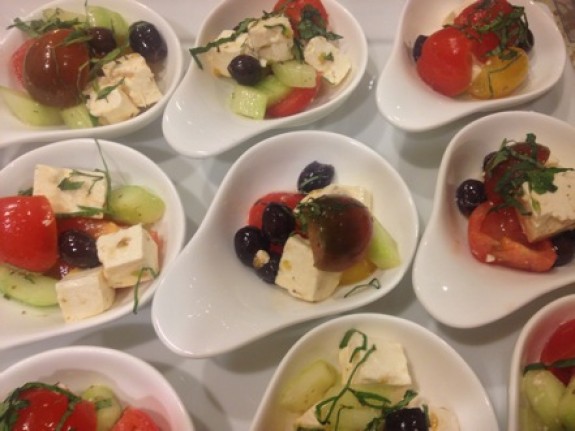
Greek Salad with Heirloom Tomatoes as interpreted by Four Seasons Hotel Executive Chef Douglas Anderson
Greek Salad with Heirloom Tomatoes
From Diet Simple Farm to Table Recipes: 50 New Reasons to Cook in Season!
8 servings
Ingredients:
Vinaigrette:
2 Tablespoons Freshly Harvested Extra Virgin Olive Oil
2 Tablespoons Freshly Squeezed Lemon Juice (1 Lemon)
1 Tablespoon Chopped Fresh Oregano or Basil (or 1 tsp dried)
1 Clove Garlic, Minced (optional)
Salt and Pepper to Taste (Salt is not necessary with the cheese and olives)
Vegetables:
2 cucumbers, peeled, seeded and sliced into a half-moon shape
1 onion, peeled and chopped coarsely
1 medium yellow, purple or green bell pepper, cored, seeded, chopped into large bite-size pieces
1 cup pitted Kalamata or other Greek Olives
4 Heirloom Tomatoes, quartered, and cut into large, bite-size pieces
4 ounces Feta or Goat Cheese, broken into small bits
Instructions:
Combine the vinaigrette ingredients in a large salad bowl and whisk until blended. Add the cucumbers, onion, pepper, and olives and toss into vinaigrette. Let sit for twenty minutes to marinate. Add the heirloom tomatoes and cheese when ready to serve.
Tomatoes are one of the “superfoods.” Men who consumed 10 or more servings of tomato products a week had a 35% decrease in risk of prostate cancer relative to those who consumed 1.5 servings or fewer per week. This is largely attributed to “lycopene” in the tomatoes, which is also in other red fruits such as watermelon, pink grapefruit and guava. Men with lycopene levels in the top 20% had a 46% decrease in risk of heart attack compared to those in the bottom 20%. Lycopene is a potent scavenger of gene-damaging free radicals. But don’t expect to get it from a supplement. You must eat the tomato as you need the whole food to receive the benefits! Here’s an explanation…
Lycopene (Red fruits such as tomatoes, watermelon, guava): Many studies have shown that lycopene-rich foods reduce the risk of prostate cancer, but the mechanism behind that reduction was not well understood until now. A recent study found that lycopene has a substantial protective effect against prostate cancer by interfering with the genes that would allow the prostate cancer cells to grow and survive. The American Institute for Cancer Research recommends that men take advantage of lycopene’s cancer-preventing effects and fill their diets with foods such as tomatoes, watermelon and guava.
- Bottom line: Fill your diet with lycopene-rich foods such as tomatoes, watermelon, and red grapefruit. Remember—the cancer-fighting properties of lycopene in tomatoes are much stronger when the tomatoes are cooked, such as in marinara sauce or tomato soup.
Katherine’s Labor Day Recipe: Fresh Summer Salsa with Watermelon
- At August 30, 2012
- By Katherine
- In News, Recipes
 0
0
My Aunt Betse has been making fresh salsa since the 1960s when she and her engineer husband lived in South America. So I have been exposed to fresh salsa long before its popularity took off in the United States. In fact, I suppose I could have been a multi-gazillionaire by now if my college roommate and I decided to go ahead with our idea of packaging and selling my fresh salsa in the early 1980s. Oh well…
Salsa is traditionally made with tomatoes, onions, hot pepper, cilantro, lime juice and salt. But I like to add seasonal fruits and vegetables to keep it interesting. In the spring, I add strawberries, in the summer, it’s watermelon, which is especially sweet this year. You could even add celery, carrots, greens, mangos – really, anything goes. In the winter, use canned Italian plum tomatoes.
Today is the 6th of “Katherine’s Weekly Market Recipes,” all of which are designed to be delicious, easy, quick, family-friendly, nutritious (heart-healthy & diabetes-friendly), and to highlight produce found at our local Farmers Markets this week. At your Farmers Market, you’ll find produce picked at peak ripeness, which means maximum flavor, texture and nutrition. You’re also helping save the environment when you buy at your Farmers Market. Here’s how…
So that your salsa is enjoyed for Labor Day festivities, I recommend you buy the tomatoes, watermelon, onion and peppers at the Glover Park – Burleith Farmers Market on Saturday, Dupont Circle’s Fresh Farm Market on Sunday, and Georgetown’s Rose Park Market on Wednesday.
excerpted from “Diet Simple: 195 Mental Tricks, Substitutions, Habits & Inspirations” (LifeLine Press, 2011)
I usually use vine-ripe tomatoes for my fresh salsa, excerpted from my book, Diet Simple. But watermelon is a surprising and exotically delicious substitute for all the tomatoes, or just half of them – as in this version. Serve this salsa with grilled salmon, chicken or beef… even tortilla chips… whatever you may traditionally use salsa with. My friend, Marc Marzullo, said this salsa was “refreshing, light, and delicious, and I especially like the vegetables chopped in larger chunks.” Since this salsa is getting eaten up today, I didn’t bother adding the lime juice. If you would like your salsa to last longer in your refrigerator, use vinegar instead of lime juice.
22 servings
Ingredients:
1 lb vine-ripe, fresh tomatoes, coarsely chopped (start with about 1-1/2 lbs)
1 lb chopped watermelon, seeds removed
1 large candy onion, peeled and chopped (about ½ pound)
3 – 4 jalapeno peppers (1 – 2 ounces) – or other hot seasonal peppers, to taste
¼ cup chopped fresh cilantro
½ tsp salt, or to taste
freshly ground pepper, to taste
3 – 4 Tbsp fresh lime juice (1 – 2 limes), optional, or vinegar if you wish for the salsa to last longer in your refrigerator
Add the onion to the tomatoes and watermelon. Finely chop 2 of the jalapeno peppers to start with. Taste. If you desire more heat, add 1 – 2 more jalapenos. Mix in the cilantro. Add the salt and pepper, depending on your taste. Mix in the lime juice, if you wish.

